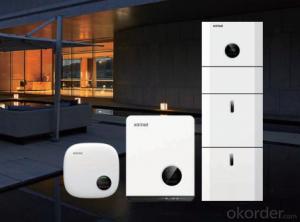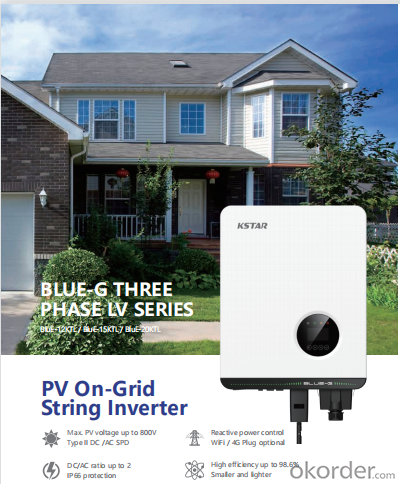New Solar Inverter PV On-Grid String Inverter Blue-12KTL / Blue-15KTL / Blue-20KTL
- Loading Port:
- China main port
- Payment Terms:
- TT OR LC
- Min Order Qty:
- 50 pc
- Supply Capability:
- 15000 pc/month
OKorder Service Pledge
OKorder Financial Service
You Might Also Like
Specification
Product Description:
★Max. PV voltage up to 800V Type II DC /AC SPD
★DC/AC ratio up to 2 IP66 protection
★High efficiency up to 98.6% Smaller and lighter
★Reactive power control WiFi / 4G Plug optional
Technical Specifications:
| MODEL | BluE-12KTL | BluE-15KTL | BluE-20KTL |
| Input(DC) | |||
| Max. DC voltage | 800V | 800V | 800V |
| Nominal voltage | 370V | 370V | 370V |
| Start voltage | 180V | 180V | 180V |
| MPPT voltage range | 200V-750V | 200V-750V | 200V-750V |
| Number of MPP tracker | 2 | 2 | 2 |
| Strings per MPP tracker | 2 | 2 | 2 |
| Max. Input current Per MPPT | 30A | 30A | 30A |
| Max. short-circuit current per MPPT | 40A | 40A | 40A |
| Output(AC) | |||
| Nominal AC output power | 12000W | 15000W | 20000W |
| Max. AC apparent power | 13200VA | 16500VA | 22000VA |
| Nominal AC Voltage | 220V 3L+N | 220V 3L+N | 220V 3L+N |
| AC Grid frequency Range | 50Hz / 60Hz±5Hz | 50Hz / 60Hz±5Hz | 50Hz / 60Hz±5Hz |
| Max. Output Current (A) | 34.6A | 43.3A | 57.7A |
| Power Factor (cos ) | 0.8 leading to 0.8 lagging | ||
| THDi | <3% | ||
| Efficiency | |||
| Max. Efficiency | 98.60% | 98.60% | 98.60% |
| Euro Efficiency | 98.30% | 98.30% | 98.30% |
| Protection devices | |||
| DC Switch | Yes | ||
| Anti-islanding Protection | Yes | ||
| Output Over Current | Yes | ||
| DC Reverse Polarity Protection | Yes | ||
| String Fault Detection | Yes | ||
| AC/DC Surge protection | DC: Type II / AC: Type III / Type II Optional | ||
| Insulation Detection | Yes | ||
| AC Short Circuit Protection | Yes | ||
| General Specifications | |||
| Dimensions W x H x D (mm) | 380*483*193 | 380*483*227 | 380*483*227 |
| Weight(kg) | <25 | <35 | <35 |
| Environment | |||
| Operating Temperature range | –25℃~+60℃ | ||
| Cooling Type | Fan Cooling | ||
| Max. Operation Altitude | 4000m | ||
| Max. Operation Humidity | 0-100%(No Condensation) | ||
| AC Output Terminal Type | Quick Connector | ||
| Topology | IP66 | ||
| IP Class | Transformer-less | ||
| Communication Interface | RS485/WIFI/4G | ||
| Display | LCD | ||
| Certification & Standard | EN/IEC62109-1/2;IEC/EN61000-6-2;IEC/EN61000-6-4;IEC61683; IEC60068;IEC60529;IEC62116;IEC61727; | ||
FAQ:
Q:How the output voltage of the PV inverter and the grid-connected voltage are determined
Inverter is the DC power (battery, battery) into alternating current (usually 220V, 50Hz sine wave). It consists of inverter bridge, control logic and filter circuit. Widely used in air conditioning, home theater, electric wheel, power tools, sewing machines, DVD, VCD, computer, TV, washing machine, range hood, refrigerator, video recorders, massage, fan, lighting and so on. In foreign countries
Q:Installation and maintenance of photovoltaic grid - connected inverter
only when the local power sector permission by the professional and technical personnel to complete all the electrical connection before the inverter can be connected.
Q:What is the difference between a PV grid-connected inverter and an off-grid inverter?
Off-grid inverter is equivalent to their own to establish an independent small power grid, mainly to control their own voltage, is a voltage source.
Q:After the PV inverter, how to achieve the same period before the network?
Solar panel simulator: with MPPT function, simulated morning, noon, afternoon, evening, rainy weather, solar panels produced under different conditions in different voltages.
Q:Is the PV inverter a current source or a voltage source?
According to the waveform modulation method can be divided into square wave inverter, stepped wave inverter, sine wave inverter and modular three-phase inverter.
Q:Photovoltaic grid-connected inverter without DC emc how will happen
Solar photovoltaic power generation technology is the use of solar cells, the photovoltaic effect of semiconductor materials, solar radiation can be directly converted into a new type of power generation system, solar energy is a radiant energy, solar power means --- to direct conversion of sunlight Into electricity,
Q:What is the difference between low voltage grid connection and medium voltage grid connection?
For photovoltaic power plants when the power system accidents or disturbances caused by photovoltaic power plant grid voltage drop, in a certain voltage drop range and time interval, the photovoltaic power plant can ensure that non-off-line continuous operation.
Q:Is the grid side of the grid and the inverter?
The grid load side of the grid is the grid. The inverter is an important part of the PV grid-connected system and can not be regarded as an external load. Photovoltaic power generation system is included in both grid and off-grid.
Q:PV grid-connected inverter and independent inverter in the control of what is the difference
The independent inverter in the output voltage phase amplitude of the frequency control is initially set good. Independent inverter, you should refer to off-grid inverter, do not need to consider the grid situation.
Product Images:




Production Process Photos:





- Q: What is the role of a surge protector in a solar inverter?
- The role of a surge protector in a solar inverter is to protect the sensitive electronic components of the inverter from power surges or voltage spikes that may occur in the electrical grid. By diverting excess voltage away from the inverter, it helps to prevent damage and ensure the reliable operation of the solar system.
- Q: Can a solar inverter be used with different solar panel technologies?
- Yes, a solar inverter can be used with different solar panel technologies as long as the output voltage and current specifications of the panels are compatible with the inverter. However, it is important to ensure that the inverter is designed to work with the specific characteristics and voltage range of the solar panel technology being used for optimal performance and efficiency.
- Q: Can a solar inverter be used in a commercial solar system?
- Yes, a solar inverter can be used in a commercial solar system. A solar inverter is an essential component of a solar system as it converts the direct current (DC) generated by the solar panels into alternating current (AC) that can be used to power commercial buildings and equipment.
- Q: What are the safety certifications for a solar inverter?
- Some common safety certifications for solar inverters include UL 1741, IEC 62109, and CSA C22.2 No. 107.1. These certifications ensure that the inverters meet specific safety standards and requirements, such as protection against electrical shock, fire hazards, and grid stability.
- Q: What is the role of a solar inverter in a net metering system?
- The role of a solar inverter in a net metering system is to convert the direct current (DC) electricity generated by the solar panels into alternating current (AC) electricity, which is compatible with the electrical grid. The inverter also synchronizes the solar system with the grid, ensuring that excess electricity generated by the solar panels is fed back into the grid, allowing for net metering and the possibility of earning credits for the surplus energy generated.
- Q: How does a solar inverter handle voltage dips and swells?
- A solar inverter handles voltage dips and swells by constantly monitoring the incoming voltage from the solar panels and adjusting its output accordingly. When there is a dip in the grid voltage, the inverter compensates by injecting additional power into the system, whereas during voltage swells, it reduces its power output to prevent damage. This dynamic response ensures that the inverter maintains a stable and consistent voltage output, protecting both the solar system and the connected appliances.
- Q: How does the input power rating affect the performance of a solar inverter?
- The input power rating of a solar inverter directly affects its performance. A higher input power rating allows the inverter to handle a greater amount of solar energy, resulting in a higher energy conversion efficiency and overall performance. On the other hand, a lower input power rating may limit the inverter's capacity to handle larger solar systems, potentially leading to lower efficiency and reduced performance. Therefore, selecting an inverter with an appropriate input power rating is crucial to ensure optimal performance in a solar energy system.
- Q: What is the role of a solar inverter in a microgrid system?
- The role of a solar inverter in a microgrid system is to convert the direct current (DC) electricity generated by solar panels into alternating current (AC) electricity that can be used to power the electrical loads in the microgrid. It also helps to manage the flow of electricity between the solar panels, battery storage, and the grid, ensuring efficient utilization and stability of the microgrid system.
- Q: What is the maximum DC input voltage for a solar inverter?
- The maximum DC input voltage for a solar inverter typically depends on the specific model and manufacturer. However, in general, the maximum DC input voltage for most solar inverters is around 600 to 1000 volts. It is important to consult the product's specifications or contact the manufacturer to determine the exact maximum DC input voltage for a specific solar inverter model.
- Q: How does a solar inverter handle voltage dip and interruption?
- A solar inverter handles voltage dip and interruption by monitoring the grid voltage constantly. When it detects a dip in voltage or an interruption, it quickly switches to an internal power source, such as a battery or capacitors, to keep supplying power to the connected solar panels or loads. This ensures a smooth and uninterrupted power supply even during voltage fluctuations or grid outages.
Send your message to us
New Solar Inverter PV On-Grid String Inverter Blue-12KTL / Blue-15KTL / Blue-20KTL
- Loading Port:
- China main port
- Payment Terms:
- TT OR LC
- Min Order Qty:
- 50 pc
- Supply Capability:
- 15000 pc/month
OKorder Service Pledge
OKorder Financial Service
Similar products
Hot products
Hot Searches
Related keywords






























